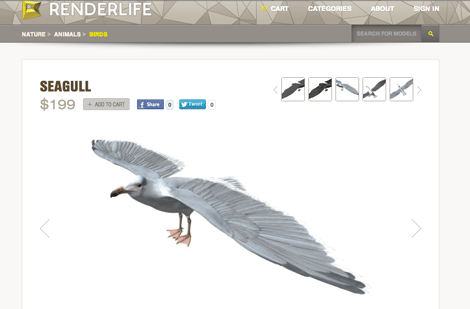
As the use of digital devices increases, digital content is going to become heavily in demand, leading to more and more online marketplaces for 3D models popping up across the web.
The latest is RenderLife, which is striving to set itself apart by standardising its service by implementing a quality control element, with the model you buy also coming as a package that can be used across all the major visualisation softwares.
RenderLife’s founder Jeff Mann recognised this need when his design studio regularly ran into issues with purchased 3D models. “Our creative team was frustrated,” explains Mann.

A simple to use UI coupled with a decent search engine means you can pick up the seagull model you’ve always dreamed of
“Too many of the models they purchased from stock sites simply didn’t work, forcing us to invest time and money to ‘fix’ what we’d already paid for. This problem and the lack of a guarantee from sellers often caused us to run late and over budget resulting in missed deadlines, and robbing us of profit on jobs.”
With no single modelling solution right for all users its 3D models come in one package containing 3DS Max, Cinema 4D and Maya files and working with studio managers and CG artists to develop its ‘Quality Code’.
The site’s curators, experienced 3D professionals, examine every model submitted to ensure it meets the site’s rigorous standards. Customers should then be left with the confidence knowing they are getting the best product every time, while content uploaders can take comfort knowing their work will be showcased with a select group of high quality models, not lost amongst lesser quality assets.
The content is a vast mixture so far, with a price range currently anything between $19 for some baby blocks, $59 for a humpback whale, or what I can only imagine is an exorbitant figure of $199 for a seagull, but this should all come into context once more content becomes available.
Among others there are categories for transport, architecture, people and even electronics, which should give enough content for rendering specialists to work with, hopefully without fear of an expensive mistake, or wrong file type.






